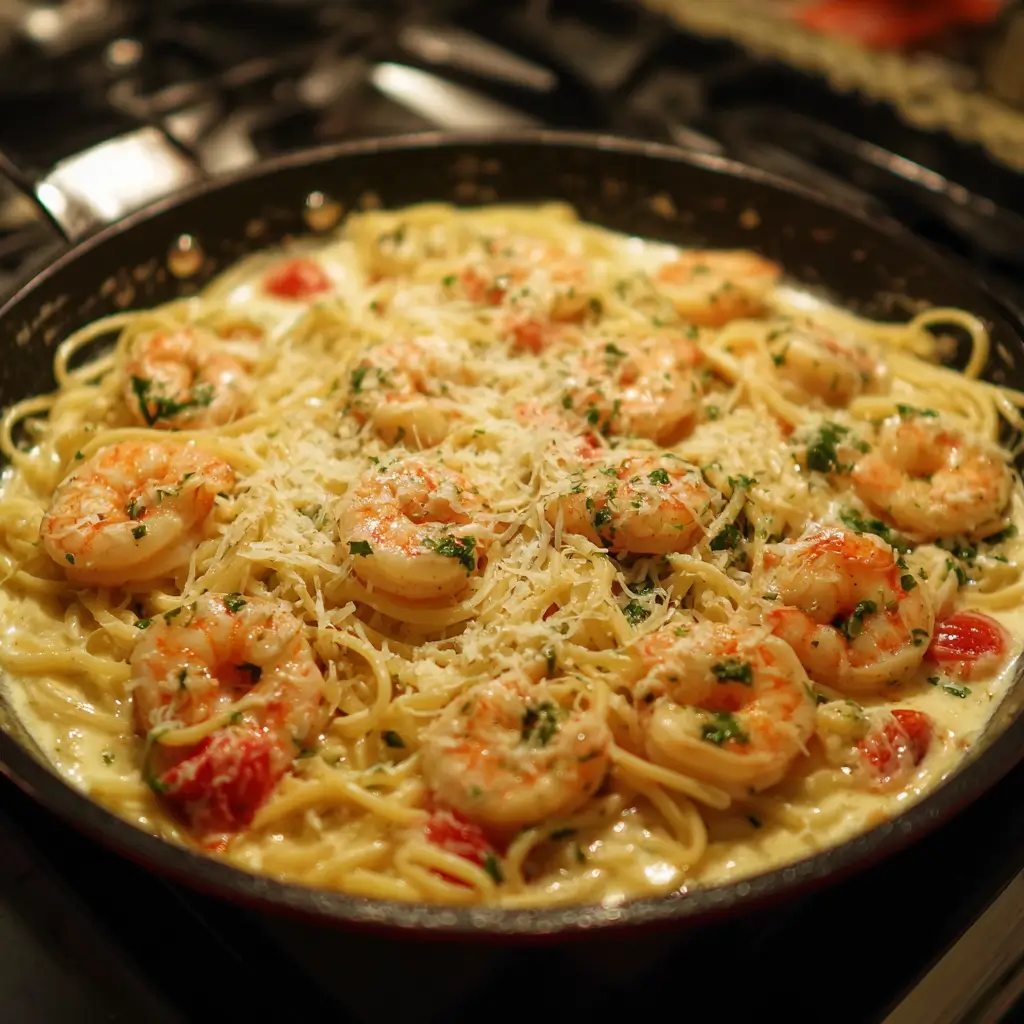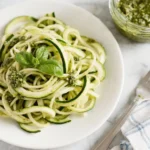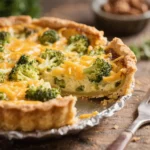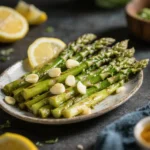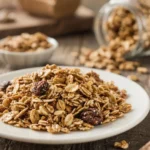Shrimp Alfredo Spaghetti: A Luxurious Pasta Delight
Introduction
Shrimp Alfredo Spaghetti is a sumptuous fusion of Italian tradition and modern American culinary flair. This elegant dish combines the delicate sweetness of fresh shrimp with the rich, creamy indulgence of classic Alfredo sauce, all twirled over perfectly cooked spaghetti. Loved by seafood enthusiasts and pasta lovers alike, it’s a restaurant-quality meal that can be recreated in your own kitchen with relative ease. Whether you’re preparing a romantic dinner for two or hosting a family gathering, Shrimp Alfredo Spaghetti offers an impressive balance of flavor, texture, and visual appeal. With its velvety sauce, tender shrimp, and al dente pasta, every bite delivers comfort and sophistication in one forkful.
The History
The origins of this dish trace back to two distinct culinary roots—Alfredo sauce and Italian-American seafood pasta traditions. The original Fettuccine Alfredo was invented in Rome in the early 20th century by Alfredo di Lelio, who created the butter-and-cheese-laden dish to entice his wife’s appetite during pregnancy. It quickly gained fame, especially among American tourists, and evolved into the creamy version popular today in the United States—often enhanced with heavy cream and garlic.
Meanwhile, the addition of shrimp reflects the broader trend of protein-enriched pasta dishes that emerged in mid-20th century America. Seafood, particularly shrimp, became a popular premium ingredient due to its mild flavor and luxurious connotation. Combining shrimp with Alfredo sauce on spaghetti (as opposed to traditional fettuccine) is a modern twist that allows for better sauce adherence and a lighter overall texture. Over time, Shrimp Alfredo Spaghetti has become a staple on Italian-American restaurant menus and home cookbooks, symbolizing both indulgence and approachability in comfort cuisine.
Ingredients Breakdown
To create a truly exceptional Shrimp Alfredo Spaghetti, each ingredient plays a vital role in building layers of flavor, richness, and texture:
- Spaghetti: The long, thin strands are ideal for capturing the creamy sauce. While traditional Alfredo uses fettuccine, spaghetti offers a slightly more delicate bite and greater versatility.
- Large Shrimp: Peeled and deveined shrimp (preferably 16–20 count per pound) provide a sweet, succulent centerpiece. Fresh or high-quality frozen shrimp work well; avoid pre-cooked shrimp as they can become rubbery when reheated.
- Heavy Cream: The base of the sauce, providing a luscious mouthfeel and enabling smooth emulsification with cheese.
- Butter: Unsalted butter adds richness and helps form the silky foundation of the sauce. High-fat European-style butter enhances depth of flavor.
- Garlic: Freshly minced garlic infuses the dish with aromatic warmth without overpowering the shrimp.
- Parmesan Cheese: Authentic Parmigiano-Reggiano is essential—it melts smoothly and imparts a nutty, salty complexity. Pre-grated cheese often contains anti-caking agents that hinder melting.
- Seasonings: Salt, freshly ground black pepper, and a pinch of nutmeg elevate the overall flavor profile subtly.
- Olive Oil: Used for sautéing the shrimp, it prevents sticking and adds a fruity undertone.
- Fresh Parsley: Chopped flat-leaf parsley adds a pop of color and freshness, balancing the dish’s richness.
- Lemon Juice (optional): A small splash can brighten the flavors and cut through the heaviness of the cream.
Step-by-Step Recipe
- Prepare Ingredients: Peel and devein the shrimp, pat them dry, and season lightly with salt and pepper. Mince the garlic and finely grate the Parmesan cheese. Measure out the heavy cream and have all ingredients ready near the stove—mise en place ensures smooth cooking.
- Cook the Spaghetti: Bring a large pot of salted water to a rolling boil (use about 1 tablespoon of salt per 4 quarts of water). Add spaghetti and cook according to package instructions until al dente—usually 8–10 minutes. Reserve 1 cup of pasta water before draining. Do not rinse the pasta, as the starch helps the sauce adhere.
- Sear the Shrimp: In a large skillet over medium-high heat, warm 1 tablespoon of olive oil. Add the seasoned shrimp in a single layer and cook for 1–2 minutes per side until pink and opaque. Remove immediately and set aside to prevent overcooking.
- Make the Alfredo Sauce: In the same skillet, reduce heat to medium. Melt ½ cup (1 stick) of unsalted butter. Add 3–4 cloves of minced garlic and sauté for 30 seconds until fragrant but not browned. Pour in 1 ½ cups of heavy cream, stirring gently. Simmer for 3–5 minutes to slightly thicken the cream, but do not boil vigorously.
- Incorporate Cheese: Gradually whisk in 1 cup of freshly grated Parmesan cheese, a handful at a time, allowing each addition to melt fully before adding more. Continue stirring until the sauce is smooth and glossy. If needed, add a splash of reserved pasta water to adjust consistency.
- Season the Sauce: Stir in freshly ground black pepper, a pinch of nutmeg, and optional lemon juice (about ½ teaspoon). Taste and adjust seasoning carefully—remember that Parmesan is salty.
- Combine Pasta and Sauce: Add the drained spaghetti directly into the skillet with the Alfredo sauce. Toss gently using tongs or a pasta fork to coat every strand evenly. If the sauce is too thick, gradually add warm pasta water, one tablespoon at a time, until desired creaminess is achieved.
- Add the Shrimp: Return the cooked shrimp to the skillet, nestling them into the pasta. Gently fold to reheat for 1 minute without overcooking the shrimp.
- Finish and Serve: Remove from heat. Sprinkle with chopped fresh parsley and additional grated Parmesan. Serve immediately while hot, ideally on warmed plates to maintain temperature.
Tips
- Don’t Overcook the Shrimp: Shrimp cook quickly and become tough if left too long on the heat. Remove them from the pan as soon as they turn pink and curl into a “C” shape.
- Use Freshly Grated Cheese: Pre-shredded cheeses contain cellulose or cornstarch to prevent clumping, which can make the sauce grainy or prevent proper melting.
- Reserve Pasta Water: The starchy liquid helps bind the sauce to the pasta and adjust thickness without diluting flavor.
- Avoid Boiling the Cream: High heat can cause the cream to separate. Keep the sauce at a gentle simmer.
- Work Quickly: Alfredo sauce can thicken rapidly as it cools. Have everything ready to combine just before serving.
- Warm Your Plates: Serving on warm dishes keeps the sauce from cooling and hardening too fast.
- Double the Batch?: This dish doesn’t reheat perfectly due to dairy separation, so consider making only what you’ll eat fresh. Leftovers can be revived with a splash of milk when reheated gently.
Variations and Customizations
While classic Shrimp Alfredo Spaghetti is divine on its own, there are countless ways to personalize the dish:
- Vegetable Add-ins: Sautéed mushrooms, spinach, sun-dried tomatoes, roasted red peppers, or asparagus can add color, nutrients, and contrasting textures.
- Protein Swaps: Replace shrimp with grilled chicken, scallops, crab meat, or even smoked salmon for different flavor profiles.
- Pasta Alternatives: Try fettuccine, linguine, tagliatelle, or gluten-free spaghetti made from rice or lentils for dietary needs.
- Dairy-Free Version: Use coconut cream, cashew cream, or store-bought plant-based cream with nutritional yeast and vegan Parmesan to mimic richness.
- Lighter Alfredo: Substitute half the heavy cream with whole milk or evaporated milk, and increase Parmesan to maintain creaminess with fewer calories.
- Spicy Kick: Add red pepper flakes, cayenne, or a dash of hot sauce to the sauce for a warming contrast.
- Hawaiian Twist: Add pineapple chunks or mango for a sweet-tropical contrast to the savory sauce.
- Herb-Infused: Stir in basil, chives, or dill for a fresher, garden-inspired variation.
- Bacon or Pancetta: Crispy bits add a smoky, salty crunch that complements the shrimp beautifully.
Health Considerations and Nutritional Value
Shrimp Alfredo Spaghetti is undeniably rich and should be enjoyed in moderation as part of a balanced diet. Here’s a breakdown of key nutritional aspects:
- Calories: A typical serving (approx. 1.5 cups) ranges from 600–800 calories, depending on portion size and ingredient proportions.
- Protein: Shrimp and Parmesan provide high-quality protein—about 25–30 grams per serving—supporting muscle repair and satiety.
- Fats: The dish is high in saturated fat due to heavy cream and butter. One serving may contain 30–40g of fat, with 15–20g being saturated. Opt for lower-fat dairy alternatives if managing cholesterol.
- Cholesterol: Shrimp naturally contain cholesterol, though recent research suggests dietary cholesterol has less impact on blood levels than once believed. Still, those with specific conditions should consult a healthcare provider.
- Sodium: Parmesan and added salt contribute to sodium content, which can reach 800–1200mg per serving. Use low-sodium versions or reduce added salt to manage intake.
- Carbohydrates: Primarily from pasta—around 60–70g per serving. Whole wheat or legume-based spaghetti increases fiber and nutrients.
- Omega-3 Fatty Acids: Shrimp offer a modest amount of heart-healthy omega-3s, beneficial for cardiovascular function.
- Vitamins & Minerals: Rich in calcium (from cheese), selenium (from shrimp), vitamin B12, and phosphorus.
For a healthier version, consider using whole grain pasta, reducing cream quantity, increasing vegetables, and choosing lean proteins. Portion control is key—serve with a side salad or steamed greens to balance the meal.
Ingredients
- 8 oz (225g) dried spaghetti
- 1 lb (450g) large shrimp, peeled and deveined
- 2 tbsp olive oil, divided
- ½ cup (1 stick / 113g) unsalted butter
- 3–4 cloves garlic, minced
- 1 ½ cups (360ml) heavy cream
- 1 cup (90g) freshly grated Parmesan cheese (preferably Parmigiano-Reggiano)
- Salt and freshly ground black pepper, to taste
- ¼ tsp ground nutmeg (optional)
- ½ tsp lemon juice (optional)
- 2 tbsp fresh parsley, chopped
- 1 tbsp reserved pasta water (plus more as needed)
Directions
- Bring a large pot of salted water to a boil. Cook spaghetti according to package directions until al dente. Reserve 1 cup of pasta water, then drain and set aside.
- Season shrimp with salt and pepper. Heat 1 tablespoon olive oil in a large skillet over medium-high heat. Add shrimp in a single layer and cook 1–2 minutes per side until pink and just cooked through. Transfer to a plate and set aside.
- In the same skillet, melt butter over medium heat. Add garlic and sauté for 30 seconds until fragrant. Pour in heavy cream and bring to a gentle simmer. Cook for 3–5 minutes, stirring occasionally, until slightly reduced.
- Gradually whisk in Parmesan cheese, a little at a time, until completely melted and sauce is smooth. Stir in nutmeg, black pepper, and lemon juice if using. Adjust seasoning to taste.
- Add cooked spaghetti to the sauce and toss thoroughly to coat. If sauce is too thick, add reserved pasta water 1 tablespoon at a time until creamy.
- Return shrimp to the skillet, gently folding them into the pasta to warm through, about 1 minute.
- Remove from heat. Garnish with chopped parsley and extra Parmesan. Serve immediately.
FAQ
Can I use pre-cooked shrimp?
Yes, but be cautious when reheating—add them at the very end just to warm through, as overcooked shrimp become rubbery.
Why is my Alfredo sauce grainy?
This usually happens when the cheese is added to a sauce that’s too hot or when using pre-shredded cheese with additives. Always melt cheese slowly over low to medium heat and use freshly grated Parmesan.
Can I make this ahead of time?
It’s best served fresh. However, you can prep ingredients in advance—peel shrimp, grate cheese, and measure liquids. Reheat leftovers gently with a splash of milk or cream to restore texture.
Is Shrimp Alfredo freezer-friendly?
Dairy-based sauces tend to separate when frozen and thawed. It’s not recommended for freezing unless you’re using a stabilizer like cornstarch or planning to repurpose leftovers into a baked casserole.
What wine pairs well with Shrimp Alfredo?
A crisp white wine such as Pinot Grigio, Sauvignon Blanc, or unoaked Chardonnay complements the richness without overwhelming the delicate shrimp.
Can I make this gluten-free?
Absolutely! Use certified gluten-free spaghetti and ensure all other ingredients (like broth or seasonings) are gluten-free. The sauce itself is naturally gluten-free.
How can I make this vegetarian?
Omit the shrimp and add sautéed mushrooms, artichokes, or zucchini. For protein, try grilled tofu or chickpeas marinated in garlic and olive oil.
Why use nutmeg in Alfredo sauce?
Nutmeg enhances the creaminess and adds a subtle warmth that balances the richness—just a pinch is enough. It’s a traditional secret ingredient in many creamy sauces.
Summary
Shrimp Alfredo Spaghetti is a decadent yet approachable dish that blends tender seafood with a luxuriously creamy Parmesan sauce over al dente pasta. Perfect for special occasions or weeknight indulgences, it’s a flavorful masterpiece that brings gourmet dining to your kitchen table.
